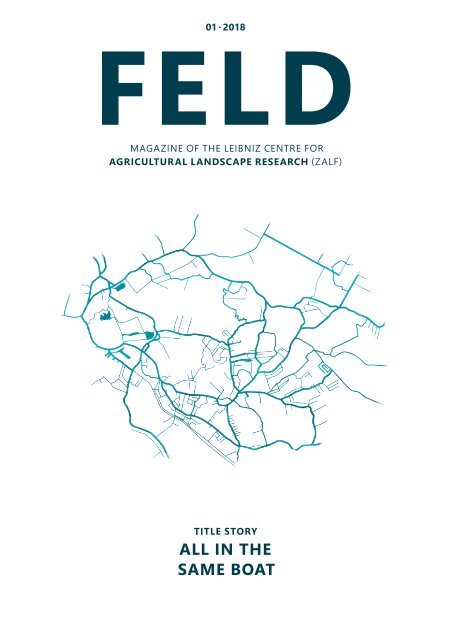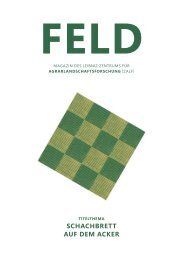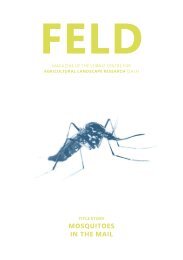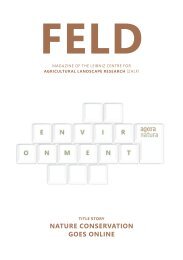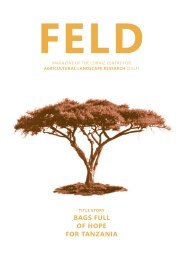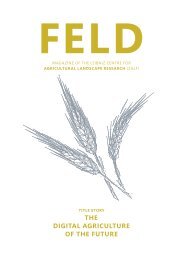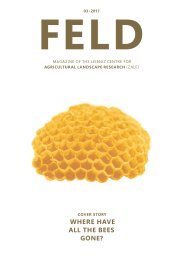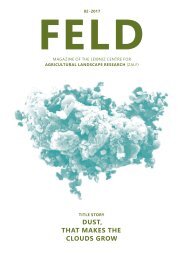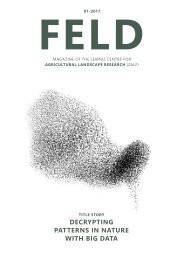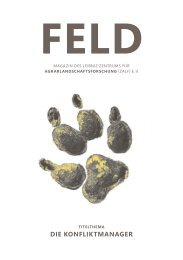FELD 01/2018
Reconciling different types of land use often leads to conflict. Researchers from Brandenburg observe and support nine German pilot projects, that test new ideas and concepts for their practicability. // Soils are precious, but our agriculture places too great a strain on them. Something has to change so that they can continue to feed us in the future. Anja-Kristina Techen investigates what the agriculture of the future could look like. // Every year, large areas of rainforest are lost throughout the world. A German-Brazilian project is looking into whether a more efficient use of already cleared areas can counteract further deforestation. // They populate every speck of soil and every square millimeter of plant surfaces. Microorganisms are increasingly becoming the focus of research. One reason for this is their unexpectedly large influence on our climate.
Reconciling different types of land use often leads to conflict. Researchers from Brandenburg observe and support nine German pilot projects, that test new ideas and concepts for their practicability. //
Soils are precious, but our agriculture places too great a strain on them. Something has to change so that they can continue to feed us in the future. Anja-Kristina Techen investigates what the agriculture of the future could look like. //
Every year, large areas of rainforest are lost throughout the world. A German-Brazilian project is looking into whether a more efficient use of already cleared areas can counteract further deforestation. //
They populate every speck of soil and every square millimeter of plant surfaces. Microorganisms are increasingly becoming the focus of research. One reason for this is their unexpectedly large influence on our climate.
You also want an ePaper? Increase the reach of your titles
YUMPU automatically turns print PDFs into web optimized ePapers that Google loves.
<strong>01</strong> · 2<strong>01</strong>8<br />
MAGAZINE OF THE LEIBNIZ CENTRE FOR<br />
AGRICULTURAL LANDSCAPE RESEARCH (ZALF)<br />
TITLE STORY<br />
ALL IN THE<br />
SAME BOAT
SUSTAINABLE DEVELOPMENT GOALS<br />
CONTENT<br />
17 »Sustainable Development Goals« are the centerpiece of the Agenda 2030,<br />
approved in 2<strong>01</strong>5 by the United Nations (UN). The Agenda lays a foundation for<br />
global economic development in accordance with social justice and within the<br />
ecological boundaries of planet earth.<br />
MORE INFO<br />
https://sustainabledevelopment.un.org/sdgs<br />
The research projects presented in this issue address the following<br />
Sustainable Development Goals:<br />
Reconciling different types of LAND USE OFTEN LEADS TO<br />
CONFLICT. Researchers from Brandenburg observe and<br />
support nine German pilot projects, that test NEW IDEAS<br />
AND CONCEPTS for their PRACTICABILITY.<br />
SOILS ARE PRECIOUS, but our agriculture places too<br />
great a strain on them. Something has to change<br />
so that they can continue to feed us in the future.<br />
Anja-Kristina Techen investigates what the<br />
AGRICULTURE OF THE FUTURE could look like.<br />
02<br />
10<br />
NO POVERTY<br />
NO FAMINE<br />
CLEAN WATER AND<br />
SANITARY FACILITIES<br />
Every year, large areas of RAINFOREST are lost throughout<br />
the world. A German-Brazilian project is looking<br />
into whether a MORE EFFICIENT USE OF ALREADY CLEARED AREAS<br />
can counteract further deforestation.<br />
20<br />
INDUSTRY,<br />
INNOVATION AND<br />
INFRASTRUCTURE<br />
CLIMATE PROTECTION<br />
MEASURES<br />
LIVING ON LAND<br />
They populate every speck of soil and every square<br />
millimeter of plant surfaces. MICRO-ORGANISMS are increasingly<br />
becoming the focus of research. One reason<br />
for this is their unexpectedly large influence on our<br />
CLIMATE.<br />
30<br />
INTERVIEW 28 · NEWS 34 · IMPRINT 36<br />
<strong>01</strong>
TITLE STORY<br />
ALL IN THE<br />
SAME BOAT<br />
Land is a finite resource. We need it to grow food, to generate energy,<br />
to build houses or to extract raw materials. Last but not least, it is<br />
the habitat of plants as well as animals and therefore needs to be<br />
protected. How can all these competing types of land use be<br />
reconciled? Which innovative concepts actually work in real life?<br />
Nine innovation groups are dealing with these questions<br />
throughout Germany, linking research and practice. A team from<br />
Brandenburg is accompanying the project from a scientific<br />
perspective.<br />
02<br />
03
Innovation groups<br />
Innovation groups<br />
In the small village of Göritz in the Spreewald, somewhat hidden on the backside<br />
of a farm barn, there is a green monster made of sheet metal and steel. Through<br />
a peephole in the front hatch you can see a glowing inferno and feel the heat<br />
coming from it. The texture of the material being burned inside is barely recognizable.<br />
They‘re bales of hay. This "hay oven" is the result of a lengthy negotiation<br />
process and decades of conflict. It is a sign of change – and of compromise.<br />
Whether it also solves the problem for which it was developed remains to be<br />
seen. There are conflicts all over Germany that have their origin in land use.<br />
Gardens, fields or meadows make way for housing developments, motorways and<br />
factories. The land which is transformed in this way amounts to more than 60<br />
hectares. Every single day. This adds up to over 220 square kilometers per year.<br />
Land becomes a contentious issue in many places: The wind turbines that arose<br />
What does sustainable land use<br />
look like? There are very different<br />
conceptions of this.<br />
IDEAS FOR NEW LAND USE<br />
And this is what makes it so special: The nine research groups do not rely on<br />
science alone. "The problems are taken directly from practice", explains Dr. Jana<br />
Zscheischler. She and her colleague Sebastian Rogga accompany the work of<br />
the groups at the Leibniz Centre for Agricultural Landscape Research (ZALF)<br />
from a scientific perspective in cooperation with the inter3 Institute for Resource<br />
Management. They investigate how science and practice can be combined in<br />
order to find viable solutions. And this is not an easy task. "There are different<br />
demands on land use. And there are always people who win and people who<br />
lose", says Zscheischler.<br />
Solar modules beneath which cows graze, regional cultural landscapes<br />
as a brand or blossom strips as habitats for plants and animals – there are many<br />
ideas for breaking new ground. With technical input, networking and coaching,<br />
the innovation groups are addressing the challenges in order to establish a<br />
future-oriented land management system that uses land resources efficiently.<br />
"The rationally acquired knowledge of science and the more experience-based<br />
knowledge of local people are brought together here", explains Sebastian Rogga.<br />
At the interface of these two types of knowledge, the potential for innovation<br />
is particularly high.<br />
DR. JANA ZSCHEISCHLER<br />
with the energy revolution, the competition between the cultivation of food and<br />
energy crops on agricultural fields or the reutilization of the former airport<br />
Tempelhof in Berlin, which was fought over for years – interests are clashing.<br />
There are often deep divisions between the various actors. Politics is beginning<br />
to take countermeasures. This is why the Federal Ministry of Education and<br />
Research launched a new research approach in 2<strong>01</strong>4. Since then, nine "Innovation<br />
Groups for Sustainable Land Management" have been looking for ways to<br />
reconcile land use interests – together with local people.<br />
In a process similar to the extraction of charcoal, the hay is carbonized in the<br />
oven. The resulting gases are burnt and thus generate heat.<br />
04 05
Innovation groups<br />
Innovation groups<br />
Many farmers say:<br />
»I want to be a farmer, not a<br />
landscape conservationist.«<br />
The "hay oven" is now the result of such a process, which experts refer to as<br />
"transdisciplinary". But why on earth is there an oven in the Spreewald to burn<br />
hay? What may at first sound strange has a serious background. It has to do<br />
with agriculture and nature conservation, tourism and wetland meadows. And<br />
a changing landscape.<br />
MOIST MEADOWS IN DANGER<br />
DR. JANA ZSCHEISCHLER<br />
Meadows and alluvial forests, through which countless small streams and<br />
channels are running, and many places can only be reached by boat – this is<br />
the Spreewald, which is admired by over a million tourists every year. It is a<br />
landscape that man has been molding and shaping for centuries. The water level<br />
was once lowered with artificially constructed watercourses in order to reclaim<br />
the marshy land of the Spree Valley. Small-scaled meadows, which usually only<br />
covered a few hectares, were mowed by hand so the hay could be dried on local<br />
haystacks and fed to the cattle. In the GDR, the land use underwent an enormous<br />
intensification. The dairy cattle were on the pastures, the water level was<br />
drastically lowered once again.<br />
Reunification gave nature conservation greater significance in the Spreewald.<br />
The water was given more freedom to preserve the unique wetland habitats,<br />
which are home to rare meadow-breeding birds such as the lapwing or the<br />
snipe. But as the water level increased, so did the farmers’ discontent, because<br />
the small-scale areas, which are hardly profitable anyway, can now only be<br />
cultivated in dry periods. Reeds and sedges are gradually conquering the<br />
meadows and rendering hay useless as animal feed. Now the grassland is in<br />
danger of becoming over-grown. In some places the changes are already visible:<br />
Alders and grey willows can be found on the first meadows. If this development<br />
continues, the land will turn into an alluvial forest. As a result, not only the cultivated<br />
landscape but also the meadows will disappear – and with them many<br />
endangered animals and plants.<br />
"Some farmers are upset", Maria Busse acknowledges. She has been<br />
addressing this problem since 2<strong>01</strong>4 in the "ginkoo" Innovation Group. The path<br />
to a solution is long. In the Spreewald, she has started to bring all those involved<br />
together. Agriculture, nature conservation, tourism and the community are<br />
exploring together, accompanied by science, to identify the problems and to try<br />
to get to know each other better.<br />
06 07
Innovation groups<br />
Innovation groups<br />
"I want to be a farmer, not a landscape conservationist", is how Jana Zscheischler<br />
sums up what many farmers think. Agriculture and nature conservation<br />
often have different interests, but are nevertheless in the same boat. In addition,<br />
there is the tourism industry, which also has a great interest in preserving the<br />
enchanting cultivated landscape.<br />
NEW OPPORTUNITIES THROUGH THERMAL EXPLOITATION<br />
Now a partial solution to the problem is in sight with the "hay oven". The wetland<br />
meadows are preserved by continuing to cultivate them. In addition to<br />
being used as animal feed, hay can now also be used as heating material. The<br />
pilot plant in Göritz already supplies the entire farm on which it is located with<br />
heat from Spreewald hay during the winter months. Even if the furnace still<br />
needs technological improvement, the concept seems to work. "The raw material<br />
is cheap and locally available. This offers great potential for the region",<br />
emphasizes Michael Petschick, who as deputy head of the Spreewald Biosphere<br />
Reserve is closely involved in the conflict and the attempts to resolve it. He can<br />
well imagine that the Spreewald hay will establish itself as a local source of heat<br />
and will not only supply farms, but also hotels and schools.<br />
Maria Busse is now exploring what the people of the region think of<br />
the idea of a "hay oven". What conditions must be met for them to participate?<br />
Over the course of several weeks, the scientist visited the Spreewald regularly<br />
to meet and interview local farmers. She wanted to reveal how incentives for<br />
innovations can be created, whether and why people accept new ideas and how<br />
best they can be taken on board. The concepts developed by Busse should also<br />
be transferable to other problems and regions.<br />
Her discussions showed that: Decisions are also determined by ethical<br />
concerns. Simply burning hay? A raw material that could theoretically be used<br />
to feed animals? The thought of this puts some people off. Others need time<br />
and arguments in order to come around to accept it. "It is important to people<br />
that they are listened to and that they can express their concerns", says Busse.<br />
Dialogue and communication are her most important tools. "Only then is it<br />
possible to implement ideas."<br />
"Only by using science, without the wealth of practical experience, we<br />
would have failed here completely", she admits. Land use is a complex issue<br />
whose problems cannot be solved piecemeal or from the outside. It needs<br />
people, who have known the region since their childhood, who have experienced<br />
and can describe the changes, who work here every day. With their<br />
Without the wealth<br />
of experience of the<br />
practitioners, we<br />
would have failed.<br />
MARIA BUSSE<br />
help, the research teams are developing a roadmap for sustainable land use<br />
and in doing so can always take the local challenges into account. But even<br />
in the Spreewald there is still a lot that is unclear, in spite of all the optimism.<br />
Nevertheless, the oven keeps on roaring and creating value out of a material<br />
that appeared to be worthless. However: "It is not clear how things will continue",<br />
Zscheischler emphasizes. Perhaps one day the oven will turn out to be<br />
either impractical or inefficient. Perhaps it will be further developed and the<br />
Spreewald hay from the moist meadows will become an important local source<br />
of energy. What will certainly remain, however, are the new networks that have<br />
been established and that will continue to provide inspiration and bring new<br />
ideas to the region. "This process will never be completed", says Maria Busse.<br />
The ZALF team will continue to accompany her on this path.<br />
THE TEAM<br />
Sebastian Rogga, Maria Busse and Dr. Jana<br />
Zscheischler (from left to right) are part<br />
of the "Co-design of Change and Innovation"<br />
working group, which is conducting<br />
research at ZALF on innovation processes<br />
in land management.<br />
www.zalf.de/feld/en<br />
08 09
MASTER PLAN FOR<br />
THE SOIL<br />
As a water filter, a habitat, a nutritional basis – soil performs many<br />
functions. But it is also vulnerable. Its structure suffers under<br />
machines that weigh tons. The lack of diversity in the cultivation of<br />
crop rotations can promote diseases and heavy rain frequently<br />
washes away fertile soil layers. If soils are to continue to feed mankind<br />
in the future, something has to change. Agricultural scientist<br />
Anja-Kristina Techen is investigating what this change might entail.<br />
10<br />
11
Soil management<br />
Soil management<br />
A broad strip of tall poplar trees are standing in the field, growing right beside<br />
it are stalks of wheat. Trees and cereals alternate in a regular pattern, row by<br />
row throughout the countryside. Wheat, maize or oats grow between tall trees.<br />
This type of cultivation, which experts refer to as an agroforestry system, can so<br />
far only be seen in Germany on a few test areas. But this method could catch on<br />
because it has certain advantages: The woodland strips protect the soil and the<br />
crops from wind and water evaporation and are home to numerous beneficial<br />
organisms. Supporters of agroforestry hope these positive effects will lead to<br />
more stable and higher yields. Trees and arable crops on one area – this is just<br />
one of many ideas that could change the face of agriculture. Dr. Anja-Kristina<br />
Techen from the Leibniz Centre for Agricultural Landscape Research (ZALF)<br />
examines which measures are particularly promising for soil management. She<br />
works in the BMBF-funded BonaRes project, Germany‘s largest research network<br />
on the topic of soil. The results of the work are intended to show how soil<br />
can be used more sustainably in the future. How yields can be increased while<br />
protecting the soil at the same time.<br />
We will have more<br />
autonomous agricultural<br />
machines, there is no longer<br />
any doubt about that.<br />
DR. ANJA-KRISTINA TECHEN<br />
SMALLER AND LIGHTER<br />
But what exactly could agriculture look like in five, ten or 20 years’ time? How<br />
will crops be sown, fertilized, irrigated, cultivated or harvested in the future?<br />
Techen has been poring over page after page of specialist literature to find<br />
answers to these questions. She is looking for indications of changes, for reasons<br />
and incentives for a new type of soil management. To date, she has evaluated<br />
more than 260 literature sources and interviewed experts from science,<br />
practice and politics.<br />
It is evident: "There are strong signals for change." Smaller, more diverse,<br />
more digital – while some approaches have so far only been discussed in research,<br />
others are already becoming more specific.<br />
Digitization, for example, has long since arrived in the field – and it will<br />
continue to intensify. "We will have more autonomous agricultural machines,<br />
there is no doubt about that", explains Techen. This is not just about self-propelled<br />
combine harvesters or tractors that navigate by GPS. For the soil functions, it<br />
does not matter whether a heavy machine is driven by a person or moves autonomously<br />
across the field. Up until now, large machines are still the trend, but<br />
small, light field robots are already in the pipeline.<br />
12 13
Soil management<br />
Soil management<br />
Equipped with sensors and cameras, they can control weeds, apply fertilizers<br />
or treat diseases more precisely. Some of these small, smart devices are already<br />
in use on test areas.<br />
THE CHANGE IS VISIBLE<br />
However, it is still uncertain whether small autonomous machines will really<br />
shape the agriculture of the future. Experts do not expect their widespread use<br />
for another 15 to 20 years. One thing is clear, however: "We have reached the limit.<br />
Larger and more productive agricultural machines are practically impossible",<br />
says Techen. A limit seems also being reached with crop rotations, in which the<br />
same crop species are continually cultivated in quick succession. They can only<br />
be achieved by using large amounts of pesticides and have now also produced<br />
undesirable side effects: More and more weeds, pathogens and pests are developing<br />
resistance to the chemicals used. Slender foxtail and wind bent grass are<br />
typical grasses whose occurrence in some regions is now almost impossible to<br />
control with pesticides. The use of ever more crop protection products is thus<br />
leading to a dead end and the yield increases achieved in the fields are more<br />
and more often not worth the extra cost. The pressure to rethink is growing.<br />
While field robotics is still in its early stages, other technologies<br />
are further advanced: Many agricultural machines are digitized. So-called<br />
"Precision Farming", for example, lets algorithms optimize the routes a machine<br />
travels on the field, and sensors automatically control the tire pressure in order<br />
to protect the soil. Fertilizers and pesticides are no longer used all over the land,<br />
but only where there is a lack of nutrients. Although further development is still<br />
required, simpler versions of these technologies are already in use in some areas.<br />
Mixed cropping could also experience a renaissance. "The mixed cultivation of<br />
wheat and legumes such as beans offers the opportunity of increasing yields<br />
and at the same time positively influencing soil life", explains Techen. Another<br />
good idea, even if not new: deep-rooted crop plants could loosen up soils that<br />
have been compacted by machines.<br />
The use of agricultural machinery weighing tons leads to soil compaction, which<br />
obstructs the transport of water and air in the soil. This leads to poorer growing<br />
conditions for the crops.<br />
14<br />
15
Soil management<br />
Soil management<br />
QUESTIONS OF THE FUTURE<br />
Future scenarios, which are developed in the BonaRes network with stakeholders<br />
from agriculture and other interested parties, illustrate the consequences<br />
the different methods have on soils and their quality. What are the risks and<br />
opportunities involved? Which soil functions will be promoted or restricted?<br />
And how will this affect the yield? "There are many unanswered questions",<br />
Techen explains. Questions about the biological, chemical and physical processes<br />
that characterize soil structures and how they are influenced by human interference.<br />
However, the analyses go even further: they are to assess the ecological,<br />
economic as well as social impacts. After all, there is the question of how jobs<br />
could be effected by autonomous agricultural machinery.<br />
Anja-Kristina Techen knows: These are urgent issues, but whether new methods<br />
and technologies will prevail is not least a question of cost and time. Farmers<br />
will continue to use machines that they have already bought for a long time; wellestablished<br />
working methods will not be abandoned overnight. "This is where<br />
research is called for", she says. Research must not only show what effects the<br />
newly developed ideas will have on the soil, but also whether they will satisfy<br />
economic requirements and can be implemented in practice. This knowledge is<br />
necessary to pave the way for a social discussion on the agriculture of the future.<br />
There are<br />
strong signs<br />
for change.<br />
DR. ANJA-KRISTINA TECHEN<br />
Drones are an important component in "Precision Farming". They help to determine precisely<br />
where the use of water, fertilizer or pesticides is required in a field. The yield potential of the<br />
fields can thus be optimized, while the use of resources is reduced to a minimum.<br />
www.zalf.de/feld/en<br />
16 17
Innovation groups<br />
Innovation groups<br />
FACTS & FIGURES<br />
»Innovation Groups for Sustainable Land Management« 1 2 3<br />
5<br />
Aachen<br />
Cologne<br />
7<br />
Wiesbaden<br />
Mainz<br />
Saarbrücken<br />
Freiburg<br />
1<br />
Kiel<br />
Hamburg<br />
Bremen<br />
Hanover<br />
Magdeburg<br />
3<br />
Göttingen<br />
Erfurt<br />
Frankfurt (Main)<br />
Nuremberg<br />
Munich<br />
8<br />
9<br />
6<br />
Berlin<br />
4<br />
2<br />
Dresden<br />
Leipzig<br />
Regiobranding ginkoo UrbanRural Solutions<br />
Special characteristics of the cultural<br />
landscape of three rural areas within the<br />
Hamburg metropolitan region are being<br />
developed. "Branding" makes these<br />
regions known for their uniqueness –<br />
thereby strengthening the regional<br />
quality of life and added value.<br />
How can new ideas in sustainable land<br />
use be put into practice? And which instruments<br />
are helpful in doing so? To find<br />
answers ginkoo is examining two case<br />
studies: the conservation of wetland<br />
meadows in the Spreewald<br />
region and the establishment of the<br />
Can the provision of public services be<br />
improved through new cooperation?<br />
The project brings together actors from<br />
the city and (surrounding) countryside<br />
and develops strategies to provide a<br />
better network of services such as<br />
doctors and schools.<br />
dual-purpose chicken.<br />
www.regiobranding.de www.ginkoo-projekt.de www.vsl.tu-harburg.de/urbanruralsolutions<br />
4 5 6<br />
AUFWERTEN render stadt PARTHE land<br />
Does the combination of agriculture and<br />
the cultivation of energy wood work? The<br />
ecological advantages and economic<br />
viability of agroforestry systems are<br />
being tested in South Brandenburg.<br />
The urban region of Aachen has ambitious<br />
goals when it comes to renewable<br />
energies. Through a regional dialogue,<br />
the project participants are developing<br />
a concrete implementation concept for<br />
the entire region.<br />
The flood plains of the Parthe River in<br />
north-eastern Leipzig are to be<br />
preserved as a diverse cultural landscape.<br />
The project is also testing<br />
measures that bring people and the<br />
cultural landscape closer together.<br />
www.agroforst-info.de www.regionaler-dialog-aachen.de www.stadtpartheland.de<br />
7 8 9<br />
EnAHRgie APV-Resola INOLA<br />
A local concept for renewable energy is<br />
being developed that takes organizational,<br />
technical and economic aspects<br />
into account. The main focus: How can<br />
such concepts be transferred to other<br />
districts?<br />
The project investigates the<br />
potential and risks of a dual use of land,<br />
in which solar systems are installed at a<br />
height of six meters above arable land<br />
allowing conventional cultivation with<br />
agricultural machinery.<br />
Complete energy supply with<br />
renewables by 2035? The project<br />
analyzes and discusses the potential and<br />
future options for the supply of energy<br />
with the people from the Bavarian<br />
region of Oberland.<br />
The Federal Ministry of Education and Research (BMBF) supports nine teams consisting of scientists and practitioners. They<br />
are developing forward-looking and practical solutions for the use of land as an essential resource by 2020. ZALF, together<br />
with partners, is accompanying the overall project from a scientific perspective.<br />
www.enahrgie.de www.agrophotovoltaik.de www.inola-region.de<br />
More information: https://www.ideen-fuer-das-land.de/<br />
18<br />
19
THE PRICE OF<br />
THE GREEN GOLD<br />
First the rainforest is cut down, cattle farming is what follows and<br />
finally soy grows all the way to the horizon. In the Brazilian Amazon<br />
region, enormous areas of untouched nature are lost every year.<br />
One reason for this: areas that already have been cleared are often<br />
not managed efficiently enough. PhD student Anna Hampf is<br />
investigating to what extent sustainable intensification in these<br />
fields can increase yields and thus counteract further<br />
deforestation.<br />
20<br />
21
Brasil<br />
Brasil<br />
Green Desert or Green Gold – there are several metaphors for a phenomenon<br />
that has been changing the face of South America for years. Soy cultivation<br />
is rapidly expanding and devastating thousands of square kilometers of land<br />
every year. In the Brazilian state of Mato Grosso, where three million people<br />
live on an area as large as Germany and France combined, this change<br />
is particularly noticable. Here, in the southern Amazon region, which was<br />
once dominated by rainforests and savannahs, the landscape is increasingly<br />
dominated by pastures and arable land.<br />
Scientist Anna Hampf from the Leibniz Centre for Agricultural Landscape<br />
Research (ZALF) has travelled through the area several times in recent<br />
years. For the research project Carbiocial, funded by the German Federal Ministry<br />
of Education and Research, she investigated strategies for sustainable land<br />
management with partners from Germany and Brazil. The researcher knows<br />
the country well – after all, she studied here for three years. She has driven past<br />
the endless soy plantations and talked to the administrations of the huge farms.<br />
The conflict takes place in<br />
the Amazon region, but its<br />
causes lie elsewhere.<br />
ANNA HAMPF<br />
SOY FOR THE WORLD<br />
The rainforest is first converted into grazing land for livestock breeding.<br />
After a few years, large enterprises buy up the small farms and turn the land<br />
into soybean plantations. The corporations are thus circumventing the so-called<br />
soy moratorium, which has banned deforestation of rainforests in favor of soy<br />
cultivation since 2006.<br />
"Measures such as the moratorium were visibly successful from 2004, but<br />
deforestation rates have risen again in the past three years", Hampf explains.<br />
A system of deforestation, livestock farming and soybean cultivation is spreading<br />
in ever wider circles. Brazil exported almost 52 million tonnes of soy in<br />
2<strong>01</strong>7. The researcher believes that the main importers such as China, the USA<br />
and Germany also bear a great deal of responsibility for this, as the majority of<br />
Brazilian soy ends up in their cattle sheds as protein-rich feed. "The phrase 'We<br />
are eating up the rainforest' is not that far-fetched", says Hampf.<br />
The expansion of soy cultivation in Mato Grosso is pushing many<br />
small farmers and landless people into new, undeveloped forest<br />
regions to the north. The areas they clear are later bought up by<br />
the soy farming companies and the cycle starts all over again.<br />
22 23
Brasil<br />
Brasil<br />
For many people,<br />
agriculture is the only<br />
source of income.<br />
ANNA HAMPF<br />
SAVING THE RAINFOREST IS NOT ENOUGH<br />
Simply banning soy cultivation is not the solution, however. "Agriculture is<br />
the only source of income for many people in Mato Grosso", Hampf stresses.<br />
Small farmers in particular depend on it, which is why it is important to find<br />
a compromise between nature conservation and agricultural production. The<br />
doctoral student considers sustainable intensification to be an opportunity to<br />
reconcile these two aspects.<br />
With the help of MONICA, Anna Hampf analyzed how this goal can be<br />
achieved in Mato Grosso’s fields. MONICA is a mathematical simulation model<br />
that describes how carbon, nitrogen and water are balanced in agroecosystems.<br />
If the model is fed with information on temperature, soil, climate and nutrients,<br />
it simulates the crop growth.<br />
But first it has to be adjusted to the local conditions, for example the climate.<br />
Data on leaf size and plant height in the individual stages of plant development<br />
are also important variables to calibrate the model, but not always easy<br />
to obtain. Thanks to good cooperation with researchers at the state university<br />
in Mato Grosso, Hampf was able to calibrate the model to the crops most frequently<br />
cultivated there: corn, cotton and soybean plants.<br />
WITHOUT INCENTIVES, NOTHING CHANGES<br />
Simulation results showed that: With some adjustments to sowing dates, the<br />
cultivars used or optimized fertilization, higher yields could be achieved without<br />
significantly increasing the use of resources. However, the knowledge of<br />
the interrelationships is one thing, implementation of the derived recommendations<br />
is quite another. Farms can only cultivate their land efficiently if they<br />
have access to financial resources, new technologies, machinery and labor – at<br />
least that is the theory.<br />
Hampf tested this with a second model, aiming to show why certain<br />
cultivation methods were chosen or not. And how land use would change if<br />
farms had unrestricted access to capital, machinery, technology and labor. The<br />
results are sobering. "Our model shows that agricultural areas would continue<br />
24 25
Brasil<br />
Brasil<br />
to expand", Hampf explains. "As the land is still very cheap, it remains more<br />
lucrative to clear the forest and expand the land instead of cultivating existing<br />
fields more intensively." So is sustainable intensification a concept that must<br />
fail in this specific case?<br />
Hampf says the responsibility lies with the politicians. More effective<br />
controls against illegal logging, loans for sustainable farming methods or an<br />
expansion of the protected areas would be necessary to stop forest clearing.<br />
New agricultural concepts – such as the mixed production of wood and cereals<br />
– could also help to make farming more sustainable.<br />
With a climate model, Anna Hampf is assessing the impact of climate change<br />
on future crop yields in the region. The assessment shows how urgently a new<br />
approach is needed: Large-scale rainforest deforestation can lead to lower rainfalls.<br />
"It would then no longer be possible to have two harvests a year, which is<br />
currently the case. Farmers would be faced with enormous yield losses," warns<br />
the scientist. With her work she wants to demonstrate strategies to the people<br />
in Mato Grosso for them to escape this cycle of deforestation, livestock farming<br />
and soybean cultivation.<br />
The area around the city of Sinop in the north of<br />
Mato Grosso is a good example of how cleared fields, starting<br />
from urban centers and transport routes, are gradually<br />
eating their way into the rainforest.<br />
www.zalf.de/feld/en<br />
26 27
Interview<br />
RESEARCH COOPERATION WITH<br />
DEVELOPING COUNTRIES<br />
Mr. Sieber, your international research work<br />
on food security was recently selected as one<br />
of four best-practice examples for the "Leibniz<br />
in Africa" initiative of the Leibniz Association.<br />
Which regions are you working on<br />
exactly?<br />
I have participated in a total of around 30 projects<br />
all over the world, most recently with a<br />
strong focus on developing countries. In Africa,<br />
we operate specifically in Tanzania, Kenya,<br />
Uganda and Cameroon. But we also work in<br />
South America, for instance in Colombia.<br />
How can research contribute to food security<br />
in these regions?<br />
Challenges such as food security and climate<br />
change are highly complex and internationalized,<br />
not least as a result of globalized supply<br />
chains. Sustainable agricultural innovations in<br />
Tanzania, for example, require us to take a look<br />
at world trade and its impact on the region. At<br />
the same time, local solutions have to be based<br />
on the local ecological, economic and sociocultural<br />
conditions. Bringing these different<br />
perspectives together with the relevant actors<br />
is the added value that comes from international<br />
cooperation. Apart from that, we have a<br />
moral duty to participate as a partner in finding<br />
solutions. The observed problems are often<br />
the exported consequences of consumption<br />
and the use of resources in rich industrialized<br />
countries.<br />
What exactly does this scientific cooperation<br />
look like?<br />
networks are gradually emerging all over the<br />
world, which can support us as partners in the<br />
focus regions in the coming years.<br />
And are the solutions developed in these<br />
research networks more sustainable?<br />
That is exactly what we are observing. But also<br />
very important is a transdisciplinary approach,<br />
i.e. the additional involvement of decisionmakers<br />
from politics or local organizations, for<br />
example. Ideally, they participate in the formulation<br />
of the research question and are involved<br />
throughout the course of the project. On the<br />
one hand, this ensures that we work on the real<br />
problems and do not conduct research detached<br />
from their daily lives. On the other hand, the<br />
local population can then identify more strongly<br />
with the project results.<br />
How do you measure the success of projects?<br />
As is customary in science, our collaborations<br />
are measured by the number and quality of<br />
scientific publications and approved project<br />
proposals. If we cannot maintain the level<br />
required, the networks that have been built up<br />
in the research regions will disintegrate again.<br />
For me, therefore, an important prerequisite<br />
for success is that we are able be involved in a<br />
region for years to come.<br />
International cooperation to solve<br />
global challenges<br />
One very important aspect is the promotion of<br />
experts in the study regions. For example: two<br />
scientists from Tanzania are currently working<br />
here with us at ZALF. As data modelers, they<br />
combine scientific expertise with relevant knowledge<br />
about the region, the people and their<br />
traditions. In return they benefit, for example,<br />
from our technical know-how and expand their<br />
scientific community. In this way, small research<br />
DR. STEFAN SIEBER<br />
is an agricultural engineer, a lecturer at the<br />
Humboldt University of Berlin and has been working<br />
at ZALF from 2005 on. Since 2009, he works as head<br />
of a research group on the topics of food security,<br />
adaptation to climate change, bioenergy, agricultural<br />
and environmental policy and strategies for<br />
the distribution of knowledge.<br />
28<br />
29
Microorganisms<br />
FROM MICROCOSM TO<br />
CLIMATE CHANGE<br />
When Dr. Steffen Kolb talks of "sinks and sources", he does not mean the<br />
geographical form of the terrain or water sources. According to Kolb, a sink<br />
is primarily the place where a substance is stored or consumed – for example<br />
carbon dioxide in wetland and forest soils. A source is exactly the opposite.<br />
A dairy farm, for example, is a source of methane because large quantities of this<br />
gas are produced in the stomachs of cows. It has long been known that methane<br />
is driving climate change. It is the second most important greenhouse gas,<br />
although it accounts for less than 0.002 percent of the atmosphere. However,<br />
the compound are responsible for up to 17 percent of climate change and is thus<br />
around 27 times as potent as carbon dioxide.<br />
GREENHOUSE GAS AND CLOUDFORMERS<br />
They sit invisibly in the soil, on organic material, on roots and plant<br />
leaves. Millions of micro-organisms populate every grain of soil and<br />
every square millimeter of plant surface. Bacteria, fungi and yeasts<br />
are the most important organisms in this microcosm, which is increasingly<br />
becoming the focus of research. Because the smallest inhabitants<br />
of our planet have an unimaginably large influence, for<br />
example on our climate.<br />
Methane is only one of thousands of so-called trace gases in the atmosphere<br />
whose effects on the atmosphere we know little about so far. Some of them<br />
stimulate cloud formation, others are involved in the formation of ozone or<br />
contribute to climate change. Yet how these gases are produced, how they<br />
are converted within substance cycles and broken down again – many of<br />
these questions are still unanswered today. So far, only one thing is clear:<br />
microorganisms that live in soil and on plants play a central role in these cycles.<br />
Steffen Kolb takes a closer look at these organisms. He does not regard<br />
bacteria and plants as separate systems. For him, they form tight communities<br />
that are dependent upon and influence each other. He calls them "symbiomes".<br />
While the plant secretes volatile substances through its leaves, the microorganisms<br />
sitting on them use exactly these substances to feed upon. In return,<br />
they provide the plant with water and nutrients.<br />
Kolb and other researchers are certain: Land use by humans significantly<br />
influences these communities of plants and microorganisms – and thus<br />
also the release of trace gases. Fertilization, tillage, crop rotation, but also the<br />
weather or the type of irrigation – there are numerous factors that determine<br />
whether the land used is a source or a sink for particular trace gases. "The<br />
balance on a field of arable land is different from the one in a forest", says Kolb.<br />
A corn monoculture harbors different microorganisms than a beech tree in an<br />
intact forest. And even a pine forest cannot be compared to a beech forest when<br />
it comes to the balance of trace gases.<br />
30<br />
31
Microorganisms<br />
Microorganisms<br />
The conversion rates of greenhouse gases on the ZALF<br />
test fields are determined with the aid of automatic<br />
gas measurement chambers (left). Individual types of<br />
soil bacteria are isolated in the laboratory and propagated<br />
in pure cultures. The extent to which they<br />
can convert trace gases can then be examined specifically<br />
(right).<br />
Which gases are formed in which concentrations by different crop plants and<br />
their tiny biological partners, Kolb and his team are investigating using cylindrical<br />
containers called incubation chambers. Located in the Leibniz Centre for<br />
Agricultural Landscape Research‘s (ZALF) own greenhouse, plants are grown<br />
individually under controlled conditions in these airtight chambers, where<br />
gases can be selectively introduced and removed. This makes it possible to analyze<br />
exactly which emissions are generated during the growing phase, for example.<br />
UNDERESTIMATED PARTNERSHIP<br />
In order to carry out these observations on a larger scale and for entire agroecosystems,<br />
the researchers work outdoors with so-called gas chambers. The<br />
up to four-meter-high devices made of transparent plastic are placed over the<br />
crop plants to measure the concentrations of gases inside. In this way, the researchers<br />
receive gas flux data over the entire course of the year and can calculate<br />
in which season or with which crops a particularly large amount of greenhouse<br />
gases such as methane, nitrous oxide or carbon dioxide is produced or stored.<br />
Kolb and his team not only want to measure, but also understand the<br />
biological drivers of these processes – namely those systems that he refers to as<br />
"symbiomes": the ecological unity between plant and microorganisms.<br />
In doing so, they are faced with an almost inconceivable diversity: "There are at<br />
least 20,000 different species of microorganism in one gram of soil", he explains.<br />
Molecular biology aids in their analysis: From soil and plant samples, the researchers<br />
not only determine which types of bacteria, fungi, yeasts and plants are<br />
present. Using sophisticated methods in laboratory experiments, they can also<br />
detect which organisms consume or produce which gases and whether stress<br />
caused by heat or drought changes the patterns of emissions.<br />
"There are interactions between plants and microorganisms<br />
that we underestimate entirely", says Kolb. More research is therefore<br />
needed – especially as the delicate balance of the atmosphere is determined by<br />
these interdependencies. "We are constantly exerting influences on these systems<br />
without knowing exactly what effects it will have", warns the researcher. His<br />
"small-scale" research is an important piece of the puzzle for solving big questions.<br />
It is so important, in fact, that ZALF has started to build the "House of<br />
Agricultural Biome Research" this year in order to foster an even better understanding<br />
of the communities of crop plants and microorganisms in the future.<br />
www.zalf.de/feld/en<br />
32 33
News<br />
News<br />
ACROSS THE FIELD<br />
TRANSFER<br />
ONLINE MARKETPLACE<br />
FOR NATURE CONSERVATION<br />
Shoes, travel, cars – there is now an online marketplace<br />
for almost everything. ZALF researchers want to transfer<br />
successful, internet-based business models to previously<br />
largely untapped territory: nature conservation.<br />
In cooperation with partners, they are developing an<br />
online platform in the "Agora Natura" project through<br />
which companies and private individuals can invest in<br />
certified nature conservation projects. The first version<br />
of the online marketplace is due to go online this summer.<br />
The first pioneering companies are already in place.<br />
More information, in particular on opportunities for<br />
participation, can be found at www.agora-natura.de.<br />
EVENT: REVIEW<br />
CONFERENCE PREMIERE:<br />
LANDSCAPE 2<strong>01</strong>8:<br />
In March 2<strong>01</strong>8, around 250 participants from 25 countries<br />
met for the first "Landscape 2<strong>01</strong>8" in Berlin. The<br />
conference, organized by ZALF in cooperation with<br />
international partners, focused on the central challenges<br />
of globalized agriculture: climate change, food security,<br />
sustainability. More than 75 lectures, 70 posters,<br />
four thematic workshops and three field trips focused<br />
on the networking of diverse scientific disciplines and<br />
actors under the thematic umbrella of Agricultural<br />
Landscape Research.<br />
RESEARCH<br />
VIRTUAL CENTRE FOR SOIL<br />
RESEARCH ON THE RIGHT TRACK<br />
"BonaRes" stands for "Soil as a sustainable resource for<br />
the bioeconomy". The aim of the initiative is to broaden<br />
the scientific understanding of soil ecosystems in order<br />
to improve soil functions and develop new strategies<br />
for their sustainable use and management. An international<br />
panel of experts has now confirmed that the<br />
research project coordinated by ZALF and UFZ has had<br />
a very successful start-up phase and that the partners<br />
involved have been successfully integrated. BonaRes<br />
is ideally equipped for the ambitious goal of providing<br />
scientific foundations for sustainable land use.<br />
EVENT: REVIEW<br />
ZALF GOES BERLIN<br />
Just in time for the peak season of mosquitoes, ZALF<br />
was present at the Long Night of Sciences in Berlin<br />
on June 9 th . Guests at the stand of the Citizen Science<br />
project "Mosquito atlas: Germany maps mosquitoes"<br />
in the Leibniz Association Building could find out<br />
everything they wanted to know about the little "pests"<br />
– and even determine the species of mosquitoes they<br />
brought along. One week later, on 17 June, visitors<br />
marveled at ZALF drones, among other things, as part<br />
of the Long Day of Urban Nature in Berlin’s Princess<br />
Gardens. Various research projects on nutrition, the<br />
environment and agriculture, a cinema showing short<br />
films and a reading corner offered a diverse program<br />
for the whole family.<br />
BEST-PRACTICE<br />
»LEIBNIZ IN AFRICA«<br />
www.zalf.de/en/aktuelles/<br />
The "Leibniz in Africa" initiative has been online since<br />
the beginning of the year. With their projects, four bestpractice<br />
participants exemplify the commitment of the<br />
Leibniz Association on the African continent. Among<br />
them: Dr. Stefan Sieber, Head of the Working Group<br />
on "Sustainable Land Use in Developing Countries" at<br />
ZALF. www.leibniz-in-africa.de<br />
34<br />
35
The Leibniz Centre for Agricultural Landscape Research (ZALF)<br />
investigates solutions to challenges in agriculture - locally, regionally and<br />
internationally: food security for a growing world population, reduced<br />
environmental footprint of agricultural land use, transformation of agrifood<br />
systems in compliance with the Sustainable Development Goals and conservation of<br />
biodiversity and ecosystem services. The work of the research centre orients<br />
itself along three dimensions:<br />
LANDSCAPE FUNCTIONING<br />
How do agricultural landscapes function?<br />
Leibniz Centre for Agricultural<br />
Landscape Research (ZALF)<br />
Eberswalder Strasse 84<br />
D-15374 Müncheberg<br />
T +49 (0) 33432 82200<br />
F +49 (0) 33432 82223<br />
Executive Board<br />
Prof. Dr. Frank Ewert (Scientific Director)<br />
Cornelia Rosenberg (Administrative Director)<br />
Public Relations<br />
Hendrik Schneider<br />
public.relations@zalf.de<br />
T +49 (0) 33432 82405<br />
Texts<br />
Heike Kampe, Tom Baumeister (Interview)<br />
Editorial Staff<br />
Tom Baumeister, Hendrik Schneider<br />
Concept<br />
Novamondo GmbH<br />
Layout<br />
Hannes Schulze, Nur Mut<br />
Photo Credits<br />
Title: Hannes Schulze / NurMut; p.2: Jürgen<br />
Sack / iStock; p. 5: Anett Kuntosch / HU Berlin;<br />
p. 6, 9 top: Michael Petschick / BR Spreewald;<br />
p. 9 bottom: Hanna von Versen / ZALF; p. 10:<br />
Valentin Valkov / Adobe Stock; p.13: Bosch;<br />
p. 14: Sascha Hübers / Pixelio; p. 16: Maurizio<br />
Gambarini / dpa; p. 20, 23, 24: Pablo Reveles; p.<br />
26: ESRI World Imagery; p. 28: Srijna Jha / ZALF; p.<br />
30: »Sinorhizobium meliloti« by Ninjatacoshell is<br />
licensed under CC BY-SA 3.0 (altered); p. 32 left:<br />
Hans-Peter Ende / ZALF; p. 32 right, 35 bottom:<br />
Jarno Müller / ZALF; p. 34: Toni Haupt; p. 35 top:<br />
Voti / Pixabay; p. 35 center: Michelle Maria / Pixabay<br />
If you would like to subscribe to this magazine free<br />
of charge, please send an e-mail with the subject<br />
line <strong>FELD</strong> and your contact information to:<br />
feld@zalf.de.<br />
© ZALF 2<strong>01</strong>8<br />
zalf_leibniz<br />
zalf.agrarlandschaftsforschung<br />
www.zalf.de<br />
LAND USE AND GOVERNANCE<br />
How can we sustainably develop and shape intensively used<br />
agricultural landscapes?<br />
LANDSCAPE RESEARCH SYNTHESIS<br />
What will future agricultural landscapes look like?<br />
A novel research infrastructure provides the necessary<br />
interdisciplinary excellence:<br />
RESEARCH PLATFORM »DATA«<br />
RESEARCH PLATFORM »MODELS & SIMULATION«<br />
EXPERIMENTAL INFRASTRUCTURE PLATFORM<br />
36
MAGAZINE OF THE LEIBNIZ CENTRE FOR<br />
AGRICULTURAL LANDSCAPE RESEARCH (ZALF)


